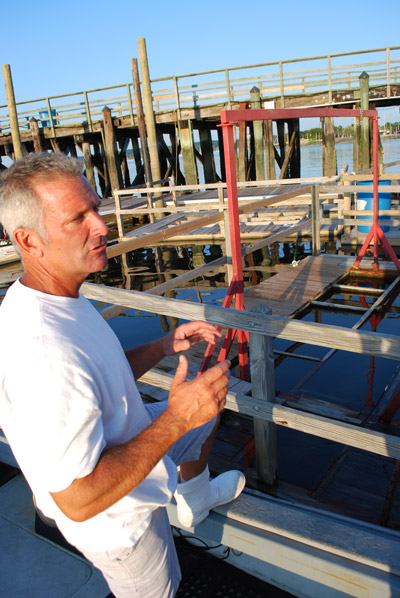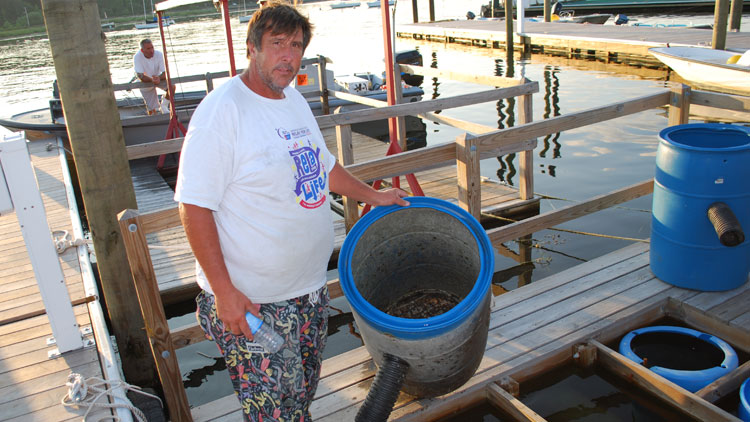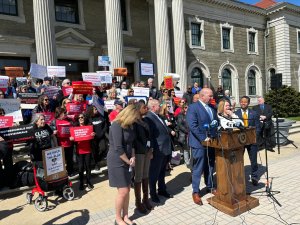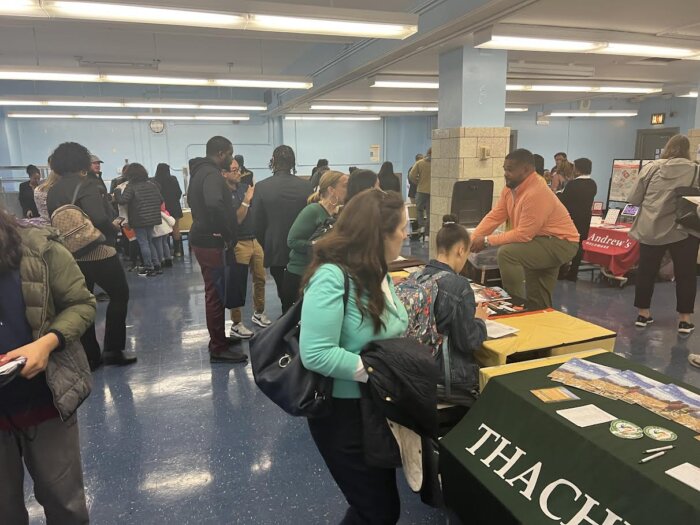Shellfishing Company Pays $2,100 Per Year For 6-Acre, Prime Town-Owned Waterfront Property and Dock Space For Fleet
Public’s Clam And Oyster Seed Incubators Intentionally Destroyed By Town, Allege Baymen
Hydraulic And Suction Dredging Of Oyster Bay National Wildlife Refuge Continues, Despite Environmental Concerns
Bill Painter and Bill Fetzer can do little but shake their heads and inspect the wreckage.
Three raft-like clam seed incubators, called Floating Upweller Systems—FLUPSYs, for short—drift lifeless in the waters off the Theodore Roosevelt Memorial Park boat ramps in Oyster Bay. It’s here Painter, Fetzer and about 70 other baymen who still scratch a living by raking hard clams and oysters off the bottom of Oyster Bay Harbor grow the public’s annual crop of four million mollusks to maturity before distributing them throughout the breathtaking, though sometimes unforgiving, waters.
Each barge holds up to 12 blue 50-gallon barrels the baymen fashioned with screens and interlaced with a network of tubes and pipe work encompassing a motorized water filtration system, spending thousands of dollars and countless hours in the process.
Instead of teeming with life, however—millions of dollars worth of clams, says James Schultz, president of the North Oyster Bay Baymen’s Association, of which Painter and Fetzer are members—the FLUPSYs lie impotent and barren, devoid of a single shell. Their motors remain silent, disconnected wires strewn in tangled heaps upon the dock. Two large blue barrels with homemade tubing protruding from their sides sit atop the mess, unattached, with a thin skin of algae. The cordoned, empty basins are thick with muddied swill, uncirculated and stagnant.
“This is our livelihood,” says a disheartened and angry Painter, a father of two who’s been working these waters for nearly three decades.
Fetzer, known as “Duckman” among clam-diggers [many of the baymen have nicknames], who’s been working Oyster Bay Harbor for more than 30 years, grabs one of the barrels and lifts it up.
“Now that the FLUPSYs are not working, we can’t better ourselves, we have no product to grow,” he laments. “We might lose years.

“This is all the product that we would be harvesting from three years from now,” he continues. “We’re upset about it and the residents should be upset about it because we’re also putting it out for the taxpayers so that father and son, mother and daughter can go get clams and have a nice dinner for themselves.”
“We just lost a whole growing season,” says Schultz. “That adds up to hundreds of thousands of dollars that’s [not] going back into the bay for the general public to harvest.”
What makes the FLUPSY system’s destruction that much more tragic is that it wasn’t caused by an act of Mother Nature, allege the baymen, but rather the Town of Oyster Bay itself—“payback,” they claim, for the baymen association’s June 2011 filing of an ongoing $750 million lawsuit against the municipality and Frank M. Flower & Sons, the last of the big, old commercial shellfishing operations still permitted to hydraulically dredge in Oyster Bay Harbor. The complaint alleges a host of misdeeds by the town and oyster company, ranging from claims Flower has been harvesting naturally occurring clams and oysters illegally (natural-growth shellfish belong to the state, and therefore, the public) from underwater beds leased from the town and those lawfully protected for the public, to environmental concerns regarding the company’s use of hydraulic dredge ships.
In January, Nassau County Supreme Court Justice Stephen A. Bucaria ruled the suit could continue on several of its most damning claims. Flower and the town have appealed.
Flower & Sons’ attorney Gary Ettelman, a founding partner of Garden City-based Ettelman & Hochheiser, P.C., who categorically denied and dismissed all the baymen’s claims when first interviewed by the Press last year, describes the current status of the suit as “kind of dead in the water.
“There’s really no teeth left of any of their claims,” Ettelman contends. “Even though the judge did allow a few of the claims to proceed, from a practical standpoint, there’s no life left in that lawsuit.”
The baymen’s attorney, Huntington-based Darrin Berger, sees it differently.
“If the case was dead, then why did they appeal the judge’s ruling?” he asks. “The main part that is most viable is the court is still considering whether the leases that were granted to Flower by the Town of Oyster Bay can stand if there are natural-growth shellfish on those leasehold interests. The court is recognizing longstanding law and statutory law that any natural growth clams that are not the product of aquaculture from Flower’s efforts belong to the public.”
“It’s very much alive,” Berger says of the suit.
Things have gotten even uglier on the high seas since the Press first covered Oyster Bay’s “Clam Wars” in an April 5, 2012 cover story documenting several of the practices contested in the baymen’s complaint, such as Flower employees’ staking and repairing flags delineating the boundaries of leased shellfish beds it rents from public grounds without the expertise of a licensed land surveyor.
Besides the latest controversy surrounding the demolition of the FLUPSYs, the baymen have been sounding off about the “sweetheart lease” of roughly six acres of prime, town-owned waterfront property where Flower docks its fleet, along with the company’s sanctioned use of hydraulic dredges to harvest their tremendous hauls—which, the baymen and local environmentalists allege, is damaging what is in actuality a National Wildlife Refuge.
On the latter issue, the baymen are now considering adopting an “if you can’t beat them, join them” strategy, since town officials support the use of Flower’s mechanical blades and suctions along the estuary’s sensitive seabed, says Schultz.
“If dredging’s so good,” he explains, “maybe the baymen association wants to buy a dredge boat and start dredging un-leased property that’s uncertified and start moving shellfish around and cultivating areas to get them better. We want to buy a dredge boat if they’re that good.”
A detailed list of questions for Oyster Bay Town Supervisor John Venditto was answered through a spokesman shortly before press time. The emailed statements verified the details of Flower’s dock lease, and, regarding the baymen’s lawsuit, expresssed the town’s belief “that the court, in its recent partial ruling, misinterpreted the regulations regarding land lease as set forth in the Town Code” and “continues to optimistically await a decision on the motion to dismiss.”
WIPED OUT

As part of a 1992 settlement to resolve another lawsuit filed by the baymen the previous year—on which Venditto was the town attorney—Flower, which owns a hatchery and grows and plants millions of clam and oyster seeds throughout the harbor annually, agreed to provide one million clam seeds to a bay management program for the public. Those seeds, along with an additional million the baymen obtain through the town from part of their $400-per-year license fee and two million more they purchase from outside vendors, comprise the FLUPSYs’ annual stock.
Painter tells the Press Flower refused to adhere to its part of the bargain to provide the seeds last summer; the baymen learned of some of the incubators’ dismemberment during shenanigans surrounding the town’s construction of a new dock that spring. Ultimately, it was too late to sow the annual crop, he says; they were consequently forced to cancel their 2 million outside seed order.
“Last fall they took all five FLUPSYs out of the water. They ended up cutting two of them up saying they were too bad to repair so they decided to discard them,” he says. “Finally, when they got the electric down here and they got the FLUPSYs in the water, there was another problem. One department from the Town of Oyster Bay took all the blue barrels, cut them up, threw them away.
VIEW OUR “CLAM WARS” MULTIMEDIA PRESENTATION, INCLUDING MORE IMAGES AND VIDEO AT www.longislandpress.com/clamwars
“We had over two million clams and we had a half a million oysters on order from an outside company,” continues Painter. “It squashed our whole deal.”
The baymen believe it was no coincidence.

Schultz claims he was personally threatened by a town official, whom he declines to publicly name, “the day the oyster company was served” and a representative from Flower, who he also declines to name publicly, thereafter. He contends the chronology reveals the town and oyster company’s too-cozy relationship and views the FLUPSYs’ demise as the consummation of those threats.
“There were two threats made,” says Schultz, matter-of-factly. “‘Your seed program and bay management will suffer,’” he says they warned him. “Two different days, two different people, two different parties.
“The destruction of our FLUPSYs was the follow-through of the original threat of our bay management and our seed program, suffering from the baymen applying a lawsuit on the town and the oyster company,” he contends. “That’s the fulfillment of their threat when they destroyed all the barrels for the FLUPSYs.
“They said they were accidentally thrown away, in the garbage truck, and that’s 30 barrels,” continues Schultz. “That’s fact, we’re not speculating.
“The town told us that,” he adds. “It was sabotage, without a doubt.”
Ettelman calls the claims “absolutely ludicrous.”
“Due to general wear and tear through years of use, as well as general effects from the weather, two of [the] Town’s five FLUPSYs were damaged upon attempt to repair, leaving three still intact and active in the water,” states the town.
Regardless of what happened, ultimately, explains Painter, it’s the pubic who will suffer, not just the baymen.
“If you had a little bit of termites in your house, you’re telling me you’re going to take down your whole house?” he asks. “We built those FLUPSYs, we could have just changed some wood in them… That’s smacking the public’s hand, because this program is done for the public benefit.”
Whether the public is actually benefitting from a lucrative lease agreement between the oyster company and the town is another question the baymen have been asking, especially given Oyster Bay’s recent financial troubles.
The town is $878 million in debt. Last month it was subject to a ratings downgrade by Standard & Poor’s, citing a “negative outlook” and “financial deterioration due to operating deficits in each of the past seven fiscal years.”
Yet instead of getting even at least the minimum fair market value for the valuable dock space land—and banking millions of dollars in the process, charge the baymen—the town is renting all that property to Flower, which online business directory Manta listed last year as netting between $20 million and $50 million annually, for a song, while also subleasing.
(Video from April 5, 2012 cover story)
SWEETHEART DEAL
On any given day, Flower’s fleet of hydraulic dredge ships and suction boats can be seen plying through the waters of Oyster Bay Harbor, usually trailed by a thick cloud of winged scavengers feeding on the carnage of sea life left in its wake or atop its deck. Unlike 20- to 24-foot clam skiffs used by diggers such as Schultz and other baymen, these floating factories are near-impossible to miss.
When Flower’s six main vessels—which range from roughly 40 to 100 feet in size, say the baymen—aren’t slicing through the shell beds with cutting blades, emulsifying the sediment with highly pressurized jets of water, or utilizing massive vacuums to siphon and gobble up the bottom of the bay, they’re docked on a roughly 6.6-acre swath of prime, town-owned waterfront property, known as Oystermen’s Dock.
Dock and slip space is hard to come by along the harbor—and expensive. Other marinas and shipyards adjacent to Oystermen’s Dock, such as Oyster Bay Marine Center (OBMC) and the 97-slip town-run boat basin in Theodore Roosevelt park, have waiting lists. Even mooring a boat—which is cheaper than renting a slip to dock and store a boat, whether during the summer or through the winter seasons—can cost hundreds, even thousands of dollars. Multiply that exponentially if you’re looking to anchor more than one boat.
OBMC, for example, charges $1,710 for a 600-lb. mooring, which typically can hold a 51- to 53-foot-long vessel and $4,825 for a 2000-lb. vessel.
Renting dock space is an entirely different ballpark.
OBMC’s smallest slip, should you be able to secure one—which can accommodate a boat up to 26 feet in length—runs between $5,650 to $5,800. Slips for vessels up to 58 feet long cost between $12,800 and $13,100. That’s just for the summer season, which typically runs from April to mid-November. A 40-foot boat with a 17-foot-beam would tally $4,624 for winter season storage, for example.
At the town’s Theodore Roosevelt marina, summer rates run $97.50 per foot during the summer and $30 per foot for winter storage.
Yet, stress the baymen, Flower pays just $2,100 per year for use of the entire six acres, through 2015, according to its lease agreement obtained by Painter, just one of a bevy of Freedom of Information Law requests filed in 2011 that was just recently fulfilled. [Originally the town had told him “there are no such records.”] The rent increases by $200 every five years.
Venditto voted in favor of the arrangement as town councilman in 1983, along with the rest of the town board, state the documents.
“I want that deal!” booms Fetzer, a father of three who lost his son Matthew about five years ago, standing on a nearby dock. “There are delis in town that are not even 300 square-foot costing three grand a month, so three grand a month versus $2,100 a year—that’s a pretty sweet deal.”
Schultz, who pays $1,500 a year just for the mooring of his skiff, wants an investigation. Painter estimates the oyster company’s true, fair market rent, were they not getting special treatment, should be around $100,000 annually—without taxes, for just the dockage.
“It’s crazy!” blasts Schultz. “They shouldn’t have leases like that when they’re in such a financial hole.”
“I don’t get it,” says Painter. “It’s tax-exempt property.
“I’m jealous,” he laughs. “Everybody would really want what Flower’s got.”
“The taxpayers of the Town of Oyster Bay are being done a disservice, in terms of the amount of revenue that’s being garnered by the town for prime waterfront land,” slams Berger. “I would be abhorred if I was a taxpayer and I knew the terms of that lease.”
“It’s too good of a deal,” adds Painter. “Taxpayers should be outraged. Outraged. Especially in this economy.”
And the Clam Wars of Oyster Bay rage on….



























